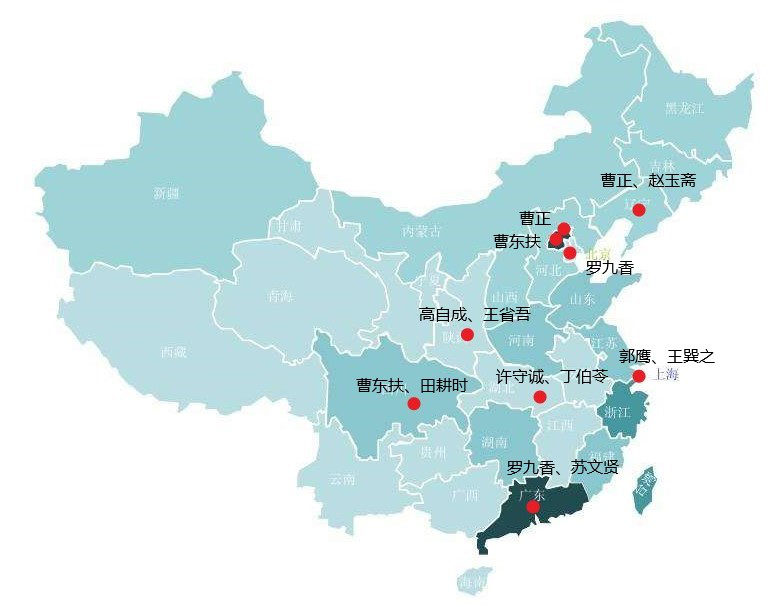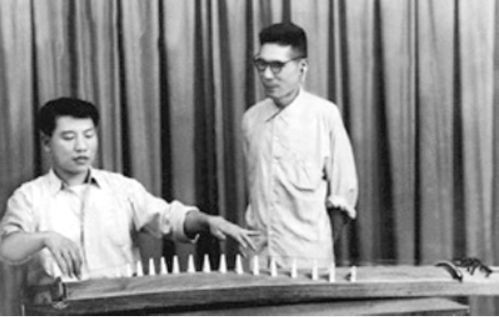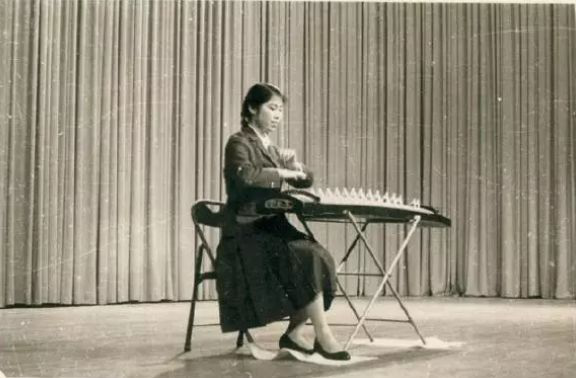Cao Dongfu and "The Lantern Festival"
Since the middle of the 20th century, with the "Northeast Conservatory of Music" (Shenyang Conservatory of Music), Central Conservatory of Music, Shanghai Conservatory of Music, Xi'an Conservatory of Music, Wuhan Conservatory of Music, Tianjin Conservatory of Music, Sichuan Conservatory of Music, Xinghai Conservatory of Music, China Conservatory of Music, etc. The nine major conservatories of music have successively opened the "Guzheng Performance" major, and the Chinese guzheng professional teaching inheritance system has gradually taken shape. From all over the country to the nine conservatories of music, such as Cao Zheng, Zhao Yuzhai, Cao Dongfu, Guo Ying, Wang Xunzhi, Gao Zicheng, Xu Shoucheng, Luo Jiuxiang, Su Wenxian, etc., gradually became the inheritance of the professional teaching of Chinese zheng music art in the mid-20th century A "rapidly rising and not to be underestimated group" in the system.

Distribution map of the first generation of zheng masters in the professional teaching of guzheng in nine conservatories of music in the middle of the 20th century (part)
In the second half of 1956, the Central Conservatory of Music was preparing to set up a guzheng major in the start-up Department of Folk Music. In order to solve the problem of teachers, Zhang Weizhao, Luo Jiuxiang, Cao Dongfu, Gao Zicheng and other representative zheng masters from different regions were invited to perform on the stage. Under such circumstances and the testimony of the teachers and students of the whole school, he became the "founder of the teaching of Guzheng at the Central Conservatory of Music" (see: Lin Shicheng "Remembering Mr. Cao Dongfu", in "The High Mountains and Flowing Water Runs the Central Plains - Mr. Cao Dongfu" 100th Birthday Book).

In 1958, Cao Dongfu was instructing students to play the guzheng
Focusing on the start-up and development of the Henan Zheng School, Mr. Cao Dongfu, the founder of the Zheng School, on the one hand, focused on arranging and ordering the "Selected Pieces of Henan Quzi Bantou", interpreting, repairing, and interpreting the "traditional repertoire" of the Henan Zheng School. Preservation and inheritance; on the other hand, headed by the public performance of "Making Lantern Festival" at the first National Music Week in 1956, he made a bold attempt, reform, development and exploration of "Creating Zheng Qu" of the Henan Zheng School. When the repair and preservation of "traditional repertoire" was initially completed, the zheng family began to focus on the "creative development" of zheng music collectively. Among the zheng masters and the zheng songs they create, "Making Lantern Festival" by Cao Dongfu is one of the typical ones.
"Making the Lantern Festival" is a warm and cheerful piece of music, which describes the festive feeling of "making" the Lantern Festival and welcoming the Chinese New Year on the 15th day of the first lunar month in Henan. The whole piece is a three-section structure with an introduction, and the overall speed increases from slow to fast, and finally ends with a presto. In the introduction part, through the block-shaped sound with alternating high and low range, the lively festival atmosphere is rendered in the scratching, finger shaking, hooking, big pinch techniques and the repetition of sound patterns. The first section of the music has the characteristics of re, sol, and do as the core, and the palace sound as the axis, which is developed according to the basic structural formula of the bantou song [Baban]. The use of materials has thus incorporated the form of "sentence and sentence pairs" that repeatedly revolved around Gongyin: the first half of the first paragraph, in the form of a "fixed tail" with Gongyin running through, appeared 17 times, Gongyin do , the quick-pressing sound on the sol and the continuous glissando on the Shangyin re also maintain a very high frequency of use in the mid-high range. Between the methods, a relatively stable "Motto" of Henan Zheng music has been formed; in the second half of the first paragraph, in the continuous consolidation of Gong Yin, the sentence width gradually splits and narrows, and begins to emphasize the change of Gong Yin Si on the plate. Using the subtle embellishment decorations with different large and small tremors, the rhythm pattern gradually increases from sparse to dense, supplemented by syncopation, dotted and other non-uniform patterns and muffled finger rests to promote the development of musical emotions, while also promoting the development of musical emotions. It lays the groundwork for the next transition of "turning the palace into a corner".
In the beginning and end of the middle section of the piece, there is a transition with the homophonic repetition of the sign sol as a turning point. The left-hand bass pizzicato is matched with the right-hand strumming pattern, simulating the connecting passages of folk gongs and drums. Immediately afterward, the technique of "turning the palace into an angle" is used to shift the tone to the upper fifth, and the playing technique unfolds around different tones along with the mode conversion. The partial tone si and #fa correspond to two different usages, functional and decorative, respectively. Marked by the phrases of the original fa, the expression of the music has entered the level of comprehensively refining the melody tones of Henan folk operas, Henan Opera, Quju, Yuetiao singing and instrumental music, such as the blending of melody tones, weak-positioned sentence patterns, and high-pitched areas. According to the continuous operation of the finger shaking, a new exploration was made on the "instrumentalization" vocabulary of Henan traditional zheng music in terms of rotation, sentence pattern, rhythm, technique, and sound area.
In the last section of the presto, due to the great increase in speed and the use of the right and left hands to pick up the sound at the same time, the expression of the music has entered the category of the impressionistic sound expression of "Lantern Festival". Head] has a certain relevance, but from the perspective of sound effects, it is more of its dynamic rhythm and the concentrated use of large pinch, strumming, scratching, and finger shaking, and the harmonic effect produced by playing five notes at the same time. It breaks the traditional way of playing Henan zheng music with the right hand and the left hand, and integrates the figurative aesthetic concept endowed with the art of zheng music in a special era.

Early performance photos of Li Bian, daughter of Cao Dongfu
The Lantern Festival created by Cao Dongfu breaks Henan's traditional zheng music vocabulary and skills into pieces, and mixes diverse local music materials from Henan folk wind and percussion music, opera music, rap music, etc., and skillfully blends the two. . Taking the iconic embellishing technique and the "characteristic instrumental vocabulary" of the Henan Zheng School as the latitude and longitude, it absorbs and digests the new sounds in the context of the times, but inevitably pursues the tension and contrast of speed, strength, and sound in the allegro paragraphs. At that time, together with other composition zheng pieces and even generalized instrumental solo pieces, it constituted one of the main paradigms of Chinese instrumental solo acoustic characteristics, melody temperament and emotional expression at that time.
If we say that the “professional” teaching inheritance of folk zhengists and the compilation and compilation of “traditional repertoire” have brought together the important achievements of folk art performances in a specific era, “making the individual lives participating in the performances connected with the changes of the whole society, and then Influenced the historical process of the entire nation-state” (see: Zhang Zhentao, “Historical Reflections on Folk Art Shows—A Measure to Protect Folk Music”, Journal of the Central Conservatory of Music, No. 3, 2008.); then, with Represented by Zhao Yuzhai's "Celebrating the Harvest Year" and Cao Dongfu's "Lantern Festival", the folk zheng masters who integrate interpretation, teaching, and creation of "trinity" have begun to collectively explore and try to "create zheng music". The national platform of the "First National Music Week" with works as the main body has greatly stimulated the trend of adapting, transplanting and creating Chinese zheng music art in the process of building a "professional" system of guzheng.
Involving the artist
Involving musical instruments
Guess you like
Hot news
- 01 The Simple Difference Between Guqin, Se, and Guzheng
- 02 The difference between the five-stringed lute and the four-stringed lute
- 03 The difference between cymbals and cymbals in ethnic musical instruments
- 04 Dulcimer exam and performance repertoire
- 05 The handsome guy in 1997 is so advanced in pulling erhu! Netizen: Come and "wash your ears"
 渝公网安备 50010702504639号
渝公网安备 50010702504639号